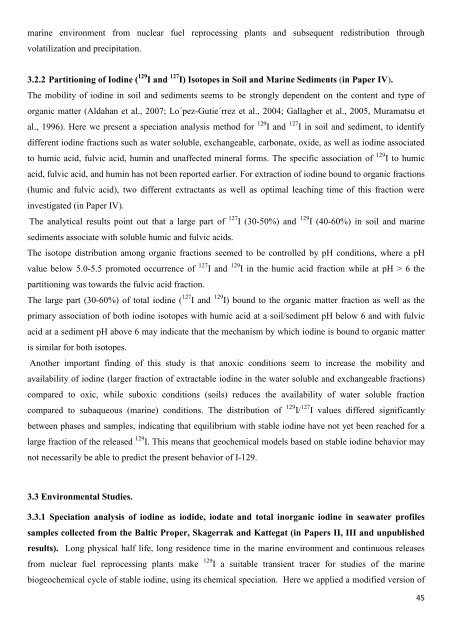Thesis for the Degree of Doctor of Philosophy - DTU Orbit
Thesis for the Degree of Doctor of Philosophy - DTU Orbit
Thesis for the Degree of Doctor of Philosophy - DTU Orbit
You also want an ePaper? Increase the reach of your titles
YUMPU automatically turns print PDFs into web optimized ePapers that Google loves.
marine environment from nuclear fuel reprocessing plants and subsequent redistribution through<br />
volatilization and precipitation.<br />
3.2.2 Partitioning <strong>of</strong> Iodine ( 129 I and 127 I) Isotopes in Soil and Marine Sediments (in Paper IV).<br />
The mobility <strong>of</strong> iodine in soil and sediments seems to be strongly dependent on <strong>the</strong> content and type <strong>of</strong><br />
organic matter (Aldahan et al., 2007; Lo´pez-Gutie´rrez et al., 2004; Gallagher et al., 2005, Muramatsu et<br />
al., 1996). Here we present a speciation analysis method <strong>for</strong> 129 I and 127 I in soil and sediment, to identify<br />
different iodine fractions such as water soluble, exchangeable, carbonate, oxide, as well as iodine associated<br />
to humic acid, fulvic acid, humin and unaffected mineral <strong>for</strong>ms. The specific association <strong>of</strong> 129 I to humic<br />
acid, fulvic acid, and humin has not been reported earlier. For extraction <strong>of</strong> iodine bound to organic fractions<br />
(humic and fulvic acid), two different extractants as well as optimal leaching time <strong>of</strong> this fraction were<br />
investigated (in Paper IV).<br />
The analytical results point out that a large part <strong>of</strong> 127 I (30-50%) and 129 I (40-60%) in soil and marine<br />
sediments associate with soluble humic and fulvic acids.<br />
The isotope distribution among organic fractions seemed to be controlled by pH conditions, where a pH<br />
value below 5.0-5.5 promoted occurrence <strong>of</strong> 127 I and 129 I in <strong>the</strong> humic acid fraction while at pH > 6 <strong>the</strong><br />
partitioning was towards <strong>the</strong> fulvic acid fraction.<br />
The large part (30-60%) <strong>of</strong> total iodine ( 127 I and 129 I) bound to <strong>the</strong> organic matter fraction as well as <strong>the</strong><br />
primary association <strong>of</strong> both iodine isotopes with humic acid at a soil/sediment pH below 6 and with fulvic<br />
acid at a sediment pH above 6 may indicate that <strong>the</strong> mechanism by which iodine is bound to organic matter<br />
is similar <strong>for</strong> both isotopes.<br />
Ano<strong>the</strong>r important finding <strong>of</strong> this study is that anoxic conditions seem to increase <strong>the</strong> mobility and<br />
availability <strong>of</strong> iodine (larger fraction <strong>of</strong> extractable iodine in <strong>the</strong> water soluble and exchangeable fractions)<br />
compared to oxic, while suboxic conditions (soils) reduces <strong>the</strong> availability <strong>of</strong> water soluble fraction<br />
compared to subaqueous (marine) conditions. The distribution <strong>of</strong> 129 I/ 127 I values differed significantly<br />
between phases and samples, indicating that equilibrium with stable iodine have not yet been reached <strong>for</strong> a<br />
large fraction <strong>of</strong> <strong>the</strong> released 129 I. This means that geochemical models based on stable iodine behavior may<br />
not necessarily be able to predict <strong>the</strong> present behavior <strong>of</strong> I-129.<br />
3.3 Environmental Studies.<br />
3.3.1 Speciation analysis <strong>of</strong> iodine as iodide, iodate and total inorganic iodine in seawater pr<strong>of</strong>iles<br />
samples collected from <strong>the</strong> Baltic Proper, Skagerrak and Kattegat (in Papers II, III and unpublished<br />
results). Long physical half life, long residence time in <strong>the</strong> marine environment and continuous releases<br />
from nuclear fuel reprocessing plants make 129 I a suitable transient tracer <strong>for</strong> studies <strong>of</strong> <strong>the</strong> marine<br />
biogeochemical cycle <strong>of</strong> stable iodine, using its chemical speciation. Here we applied a modified version <strong>of</strong><br />
45

















